Your Human Capital Strategy for Digital Transformation
The COVID-19 pandemic has created, arguably, the greatest inflection point in our lives. As a catalyst, it has led to drastic changes in work patterns and higher rates of job migration in what’s been called ‘the great resignation’.1 Businesses have been forced to consider new digital solutions, including an exponential rise in remote working, digitizing services, and pivoting entire operations online. This has accelerated digital transformation in business, leading to a greater need to develop talent and human capital strategies for a very different future of work.2
To help understand the effects of this inflection point, GetSmarter surveyed 5,808 professionals from 128 countries. This uncovered several compelling insights, starting with our survey respondents identifying COVID-19 and remote working as the two most disruptive factors in the past six to 12 months. Interestingly, it also revealed that new technologies are expected to be one of the most disruptive factors to businesses in the next two years. Crucially, only 40 percent of professionals surveyed feel their company is currently doing enough to prepare.
However, the most important finding in the survey is that the success of a digital transformation is not totally reliant on just plugging in the latest technology. The innovation and resilience required for true success is dependent on empowering and inspiring employees. The transition into a business with technology at its center also entails a shift in the culture and mindset of the organization.3 Every single team member needs to be aligned, equipped, and motivated, and this starts with leadership and strategic change management.
Unfortunately, most companies don’t experience a smooth digital transition: 74 percent of transformation projects fail to achieve their full benefits due to a lack of employee contribution.4 This underlines how human capital offers both the biggest challenge and the greatest solution. The motivation isn’t just for HR benefits: successful digital transformation is proven to create tangible business value such as new revenue streams and lower costs.5
So, the question is: what is the right human capital strategy for success? While there are common requisites such as change management and leadership, there is no one-size-fits-all HR approach; every industry requires a bespoke treatment. Businesses need a customized talent strategy that focuses on upskilling and reskilling in targeted areas, emphasizes the right leadership skills, and underlines the importance of diversity and inclusion. The HR strategy must also form part of an integrated digital framework.
Transform your company’s human resource function into a strategic driver of change management and value creation.
Unlock an effective, sustainable competitive advantage through disruptive technology.
This practical guide looks at digital transformation case studies from three leading industries and explores the unique tech-based approaches needed to succeed. All three emphasize the importance of having the right blend of specific skills, talent, and leadership ability.
The impact of digital transformation on talent
In line with the trend shown in the great resignation, the GetSmarter survey reveals that 59 percent of respondents are very likely or somewhat likely to change jobs to another business area or function in the next 6–12 months. This emphasizes how hiring and retaining talent is so important for businesses in the post-pandemic area, especially for employees with technological skills. The demand for people with IT and digital skills continues to outstrip supply.6
This shortage of skills underlines how all employees need to be upskilled with a tech focus – not just those in the IT department. Unfortunately, most companies aren’t responding quickly enough, even though employees are willing to learn. The GetSmarter survey shows that 96 percent of respondents are considering engaging in learning activities to upskill themselves. Their top reasons for this: to gain a new skill that the business needs, followed by improving in their current role.
Everyone, including leaders and the C-suite, needs to develop their skills through reskilling and upskilling, and crucially, it needs to be done in a bespoke way to suit their individual career, goals, and industry. Our survey reveals that there is one area that all employees need to focus on: technical skills and digital capabilities, especially leaders, C-suite, directors, and older generation employees who typically rely more strongly on their leadership and interpersonal skills.
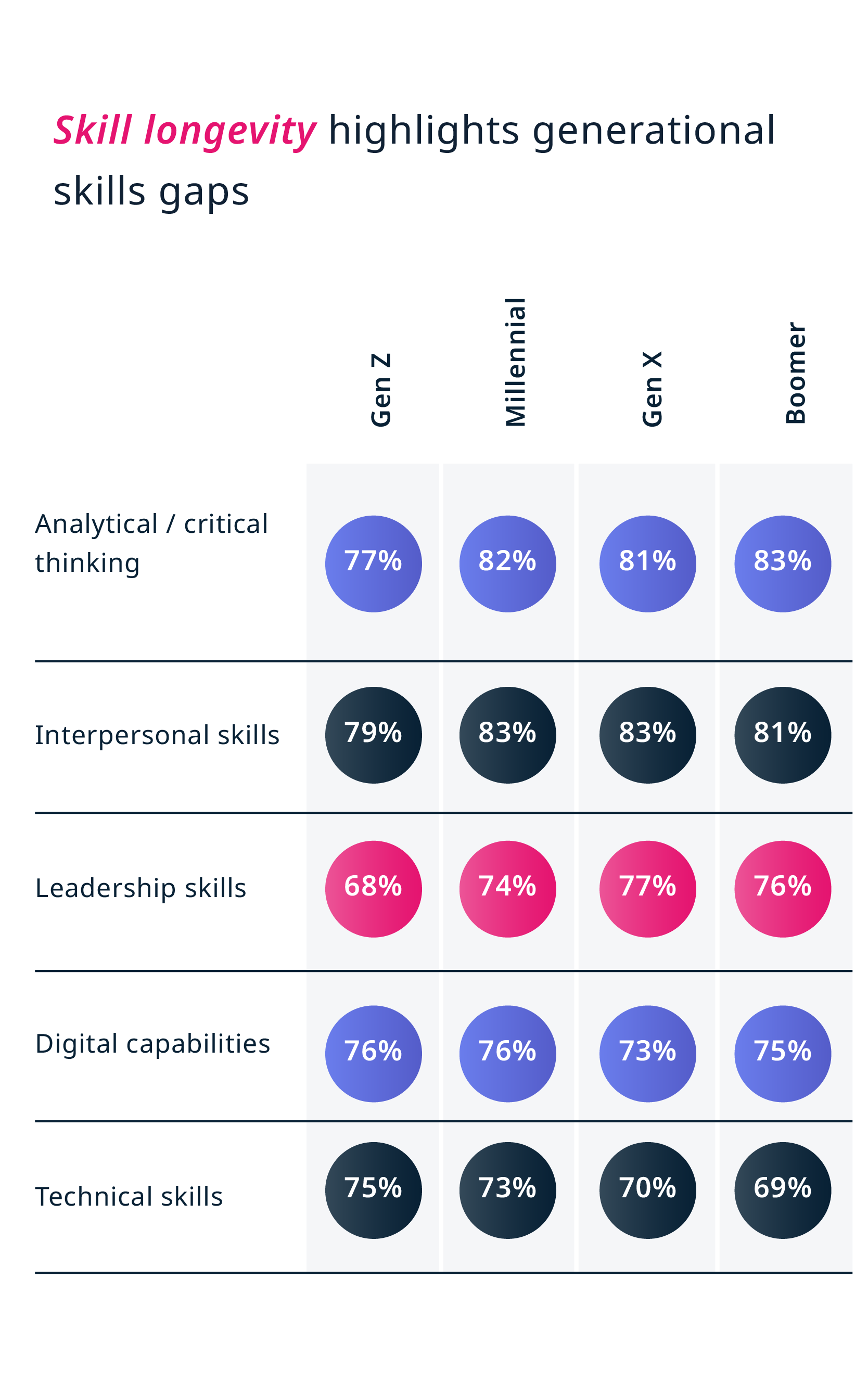
Based on the GetSmarter Skills Hierarchy, the graph shows that younger generations perceive technical skills to have greater longevity in their careers than the older generations. Conversely, the older generations perceive analytical, critical thinking skills, and interpersonal and leadership skills as having greater longevity in their careers. This reveals two crucial skills gaps. The younger generations need to improve their leadership, interpersonal, and critical thinking skills while the older generations need to improve their technical skills and digital capabilities.
This is a vital lesson for HR professionals and learning development managers; they need to identify the skill gaps in their organization and provide learning opportunities for their current employees rather than solely hiring new people. Given that the demand for employees with technical skills has outstripped supply, it makes financial and cultural sense to upskill and reskill existing team members, within the organization. Technology skills can no longer be highly centered in IT; they need to be ‘marbled’ across organizational functions and businesses and coupled with soft skills to achieve transformation success.7
There is a disclaimer in this talent strategy: the learning opportunities need to be chosen carefully. Only 51 percent of GetSmarter’s survey respondents said they find training provided by their employer to be useful. This speaks to the clear gap between what employees want and need to learn compared to what their employers are offering in learning opportunities. Most companies lack data regarding the skills they need for transformation and are not sure about how and where to develop such capabilities.8
Digital transformation can, and should, be focused on problems of greatest need to the company. Those priorities will lend a flavor both to the talent needed, and the upskilling that’s required.9
Industry case study 1: Education
The GetSmarter survey revealed that the following skills are highest in demand in the education industry and should be the focus for upskilling within this market. The following case studies demonstrate how certain skills have been leveraged for successful digital transformations in three different industries.
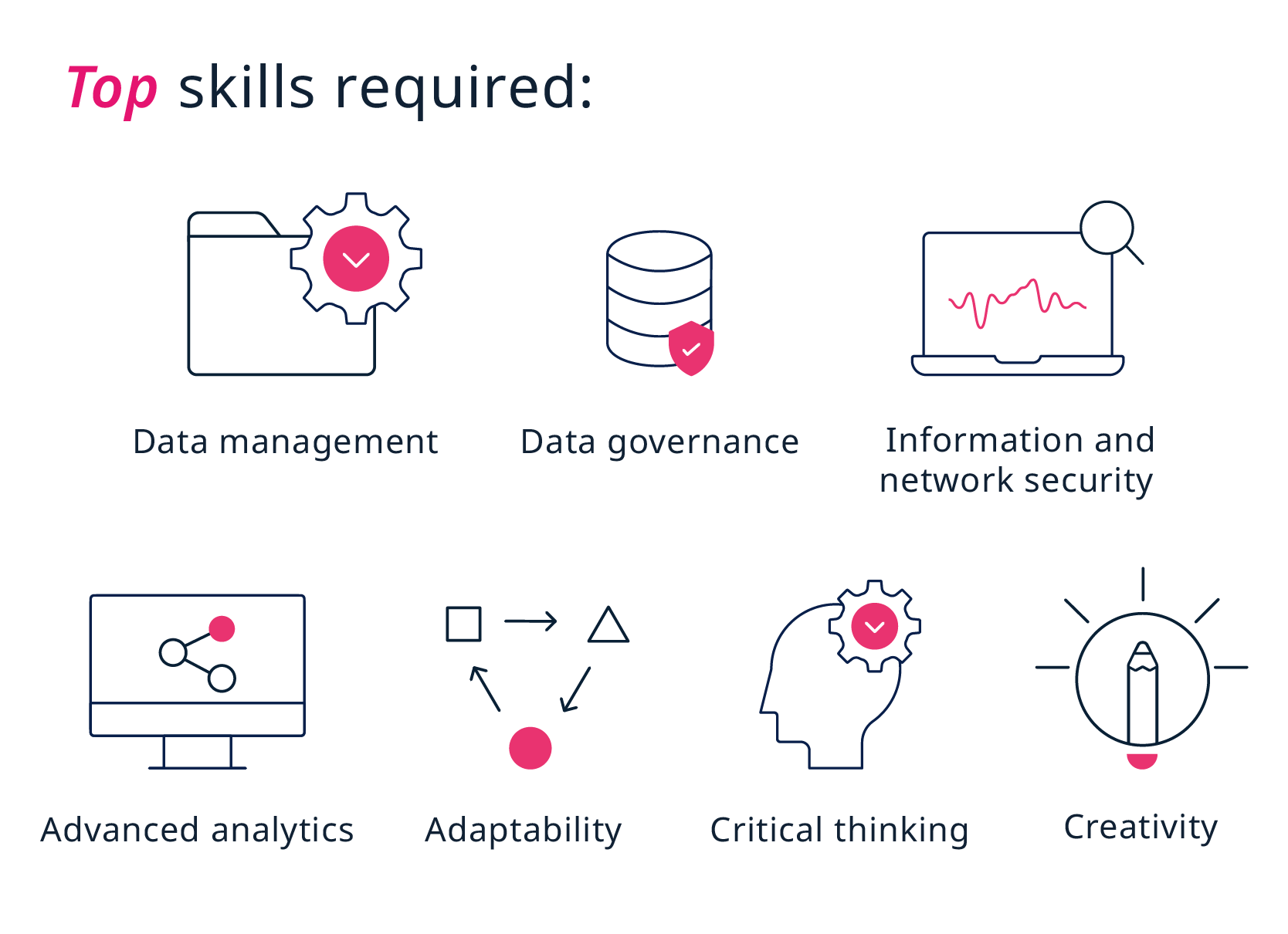
The lesson: Use technology to empower both employees and customers.
California State University (CSU) is one of the largest public universities in the United States. It has almost 50,000 employees and 500,000 students enrolled across 23 campuses.10 One of its biggest challenges: collecting, processing, and analyzing the immense volume of data.
The solution was devised by their chief data officer, Brendan Aldrich, and it involved creating a ‘data lake’; an advanced form of cloud storage combined with in-depth programming. This centralized repository enables you to store structured and unstructured data at any scale. It allows CSU to store data as is, without having to first structure the data, and allows it to run different types of analytics – from dashboards and visualizations to big data processing, real-time analytics, and machine learning (ML) to guide better decisions.11 The positives for CSU: employees have faster access to more information, they can analyze it more quickly, and they can help students more effectively. The students benefit too, as they have access to more digital functionality and learning support. It’s an effective, scalable digital solution to empowering the CSU team to work smarter and more efficiently – the perfect example of technology empowering both employees and customers.
Data lakes aren’t just used in education: the South American branch of the Coca-Cola Company, Coca-Cola Andina, used one to increase the productivity of its analytics team by 80 percent. This allows the company to make decisions based on reliable data, promoting growth, maintaining its competitive advantage, and increasing the company’s revenue.12
Industry case study 2: Financial services
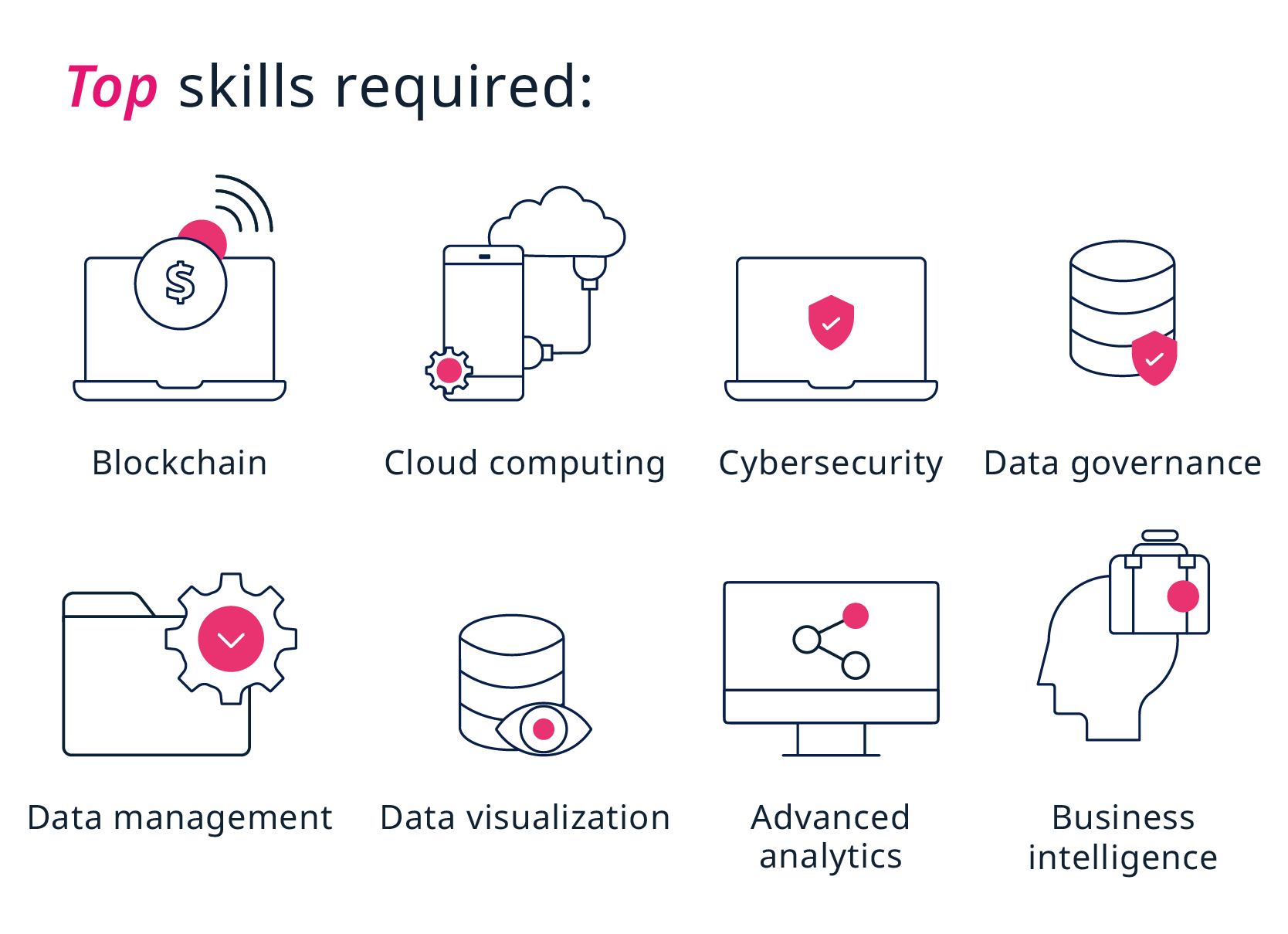
The lesson: Partnerships can share talent and technology faster, and have a cultural impact.
Deutsche Bank required a fast and global digital transformation to help it stay relevant in a market embracing cryptocurrency, blockchain, and other emerging technologies. Its response? To partner with Google Cloud on a 10-year deal. This is not just about moving banking services onto the cloud, it’s a versatile collaboration that will overhaul the bank’s technology, business model, the core value, and, crucially, its culture and approach to talent.13
Industry case study 3: Information technology
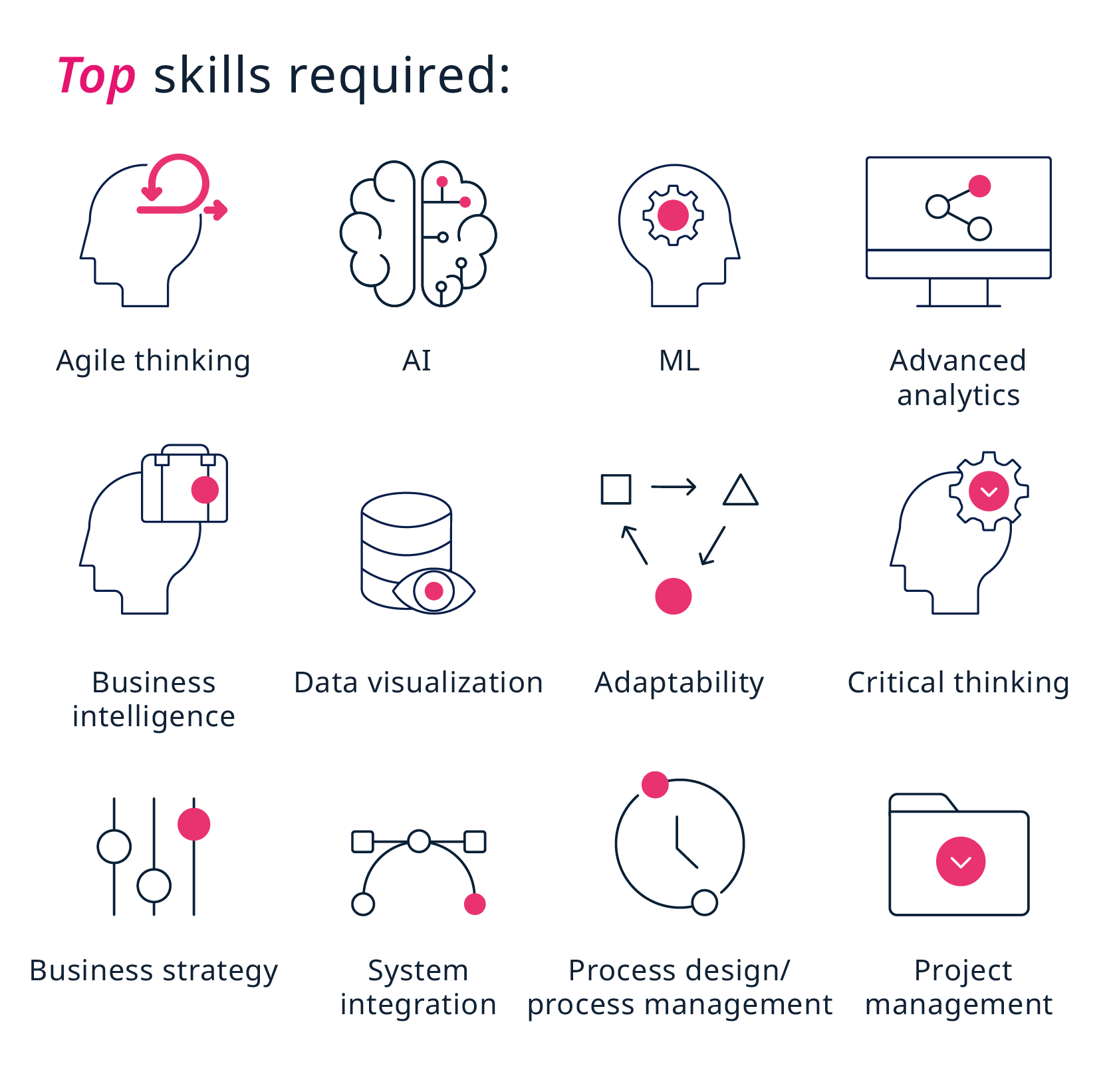
The lesson: All companies should choose innovation and technology as prime drivers.
Walmart, the U.S.-based retail giant, is not in the IT industry. However, there are reasons to justify its inclusion as an IT-focused case study. During the 2018 fiscal year alone, it spent $11.7 billion on technology, making it the third-largest IT spender globally behind Amazon and Alphabet.14 Coupled with that investment, the company has since teamed up with Adobe to offer businesses subscriptions to its proprietary e-commerce capabilities, as well as unveiled its own cloud-powered checkout system, mobile check-in technology, and app-based shopping.15
Walmart’s transformation goal is not limited to using technology to become an e-commerce business, it’s using it to transform all elements, from supply chain management through to the overall customer experience. “Digital conversion for us has to be about more than just serving the customer on the front end. It’s about more than e-commerce. We need to introduce digitization across all our functions and jobs so that we can be faster and more efficient,” says Doug MacMillon, Walmart’s CEO.16 Walmart uses shelf-scanning robots for stock-keeping, blockchain to track produce, electronic shelf labels for variability, (artificial intelligence) AI for product inventory, and more.17
However, the case study provides one crucial lesson for all companies: Walmart’s people working behind and alongside its digital platforms are the real secret weapon that will continue to power its transformation into a technology company.18
Understand how AI and machine learning is used in our everyday lives in this video with Professor Thomas Malone from the MIT Sloan School of Management.
The core focus on skills needed to future-proof success
As shown by all three case studies, it’s the mix of the right skills, leadership strategy, technology, and sound change management that results in digital transformation success. To help with the first two factors, HR professionals and learning development managers need to identify which digital transformation skills are highest in demand in their business and industry. Then, they need to upskill and reskill their workforce to fill skills gaps in the next two years. Concurrently, HR needs to clearly define career paths and offer professional development to all employees to help them advance in their careers. It also means establishing leadership development programs for the most promising employees.19 By offering learning opportunities to employees, it can also address and improve retention and employee satisfaction.
To assist with this, GetSmarter has created a Digital Transformation Skills Framework. It’s an interactive roadmap that uncovers the most valuable skills that are key to digital transformation. This is the foundation for a human capital strategy, and will help you upskill your workforce and address the knowledge gaps. Click on the different categories to see a detailed breakdown of the specific skills required.
Start the transformation
As shown by the case studies and survey results, it’s the human capital strategy that determines the success of digital transformation in business. Research shows that the greatest business transformation occurred when companies changed their people and talent strategies and focused on upskilling employees.20
HR professionals and learning development managers have to work with their leaders to craft a human capital strategy that’s customized for the specific business needs, the demands of the industry, and long-term goals. Achieving this relies heavily on two factors: following the proven five-part digital transformation framework and harnessing strategic change management.
The reward? Successful digital transformation builds careers and thriving businesses, no matter what the industry is or the disruptions that are faced. Start defining the human capital strategy for your business with the course map below. Our Enterprise division offers talented Account Managers who can help consult on the best courses to suit your company’s learning development strategies and digital transformation goals.
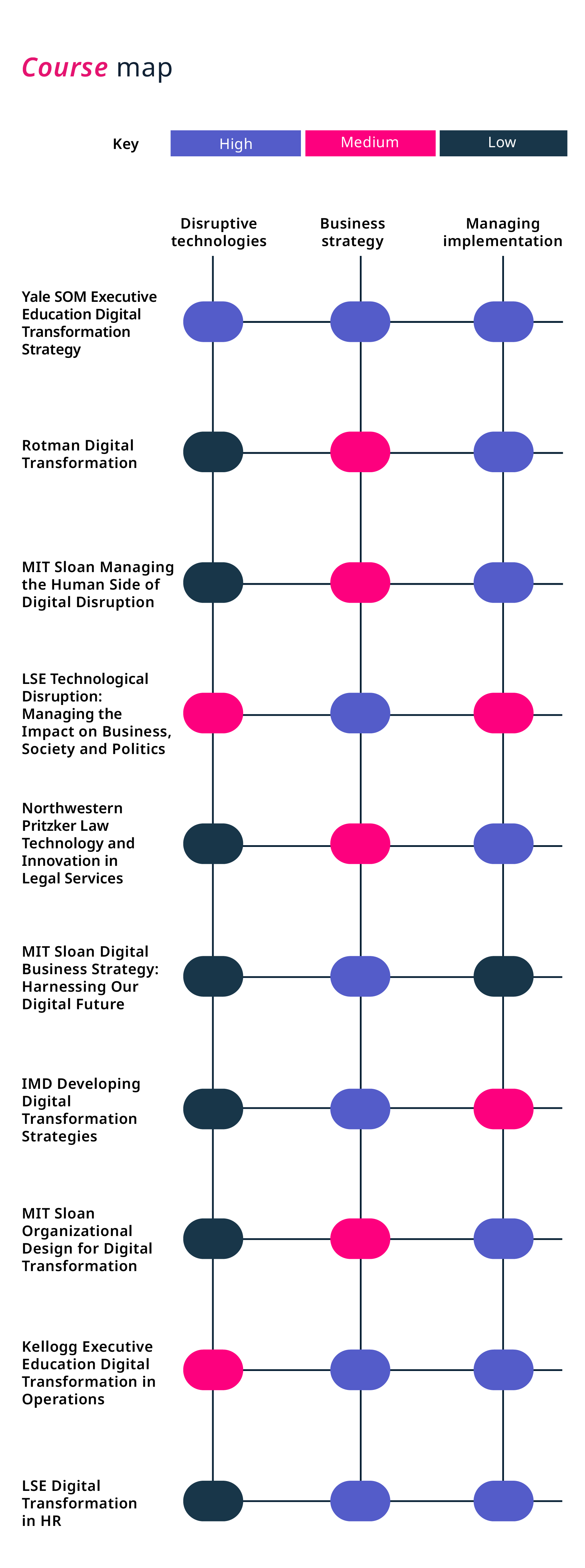
Transform both your business and your career with insights from GetSmarter’s latest research into digital transformation.
Help your workforce unlock digital transformation success
- 1 Chugh, A. (Nov, 2021). ‘What is ‘The Great Resignation’? An expert explains’. Retrieved from World Economic Forum.
- 2 Santenac, I. & Majkowski, E. (Feb, 2021). ‘How to sustain digital transformation and manage human capital’. Retrieved from EY.
- 3 Pedersen, CL. (Apr, 2022). ‘Cracking the culture code for successful digital transformation’. Retrieved from MIT Sloan Management Review.
- 4 (Nd). ‘Organizational change management and transformation’. Retrieved from Deloitte. Accessed April 28, 2022.
- 5 Dhasarathy, A., et al. (Mar, 2021). ‘Seven lessons on how technology transformations can deliver value’. Retrieved from McKinsey.
- 6 Feijao, C. et al. (2021). ‘The global digital skills gap’. Retrieved from RAND Corporation.
- 7 Macciola, A. (Oct, 2021). ‘Macciola, A. (Oct, 2021)’. Retrieved from Forbes.
- 8 (2021). ‘Technology change is business change’. Retrieved from REBA.
- 9 Arbeeny, S. (Nov, 2021). ‘Why digital transformation must start with a clear, defined mission statement’. Retrieved from Forbes.
- 10 Schaffhauser, D. (Dec, 2021). ‘California State University system wraps hybrid cloud data project’. Retrieved from Campus Technology.
- 11 (Nd). ‘What is a data lake?’. Retrieved from Amazon. Accessed 28 April, 2022.
- 12 (2021). ‘Coca-Cola Andina builds data lake on AWS, increases analytics productivity by 80% for more data-driven decision-making’. Retrieved from Amazon.
- 13 Evans, B. (Jul, 2021). ‘How Google Cloud is Deutsche Bank’s innovation engine: 15 examples’. Retrieved from Acceleration Economy.
- 14 (Nd). ‘6 Digital transformation success stories’. Retrieved from Zigurat. Accessed 29 April, 2022.
- 15 (Jul, 2021). ‘Could Walmart become the next tech giant?’. Retrieved from Yahoo! Finance.
- 16 Greene, R. (Nd). ‘CEO Doug McMillon discusses innovation and the future of Walmart’. Retrieved from ActionIQ. Accessed 29 April, 2022.
- 17 Chen, M. (May, 2021). ‘Walmart – Digital transformation of the retail giant’. Retrieved from OOSGA.
- 18 Nguyen, B. (Dec, 2021). ‘The future of retail: Putting people at the heart of our digital transformation’. Retrieved from Executive Platforms.
- 19 Santenac, I. & Majkowski, E. (Feb, 2021). ‘How to sustain digital transformation and manage human capital’. Retrieved from EY.
- 20 Dhasarathy, A., et al. (Mar, 2021). ‘Seven lessons on how technology transformations can deliver value’. Retrieved from McKinsey.
